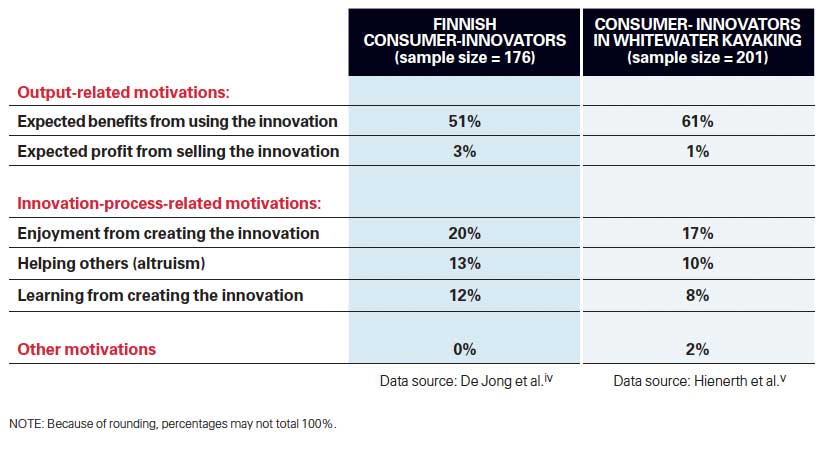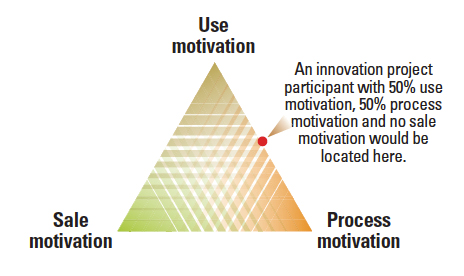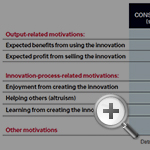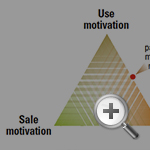Innovation Process Benefits: The Journey as Reward
Organizations can considerably amplify the resources available to their innovation projects — by helping volunteer innovators benefit from participating in the process.
Topics
When business executives and economists think about whether developing an innovation will be worthwhile, they tend to focus on the economic value of the outcome of the innovation process. “Will we earn enough profit from using or selling X innovation to justify the money and time required to develop it?” is, in effect, the question they ask.
However, that standard cost-benefit assessment is seriously incomplete when applied to individual innovators. These individuals can gain significant benefits from participation in a development process as well as — or even instead of — benefits from using or selling the innovation created.1 When innovation project sponsors can offer volunteer innovators such benefits, the net cost of those innovation projects can be much lower.
To understand this idea, consider the fact that innovation centrally involves problem solving. In other situations, problem solving is known to be valued by participants for the process itself. That is, people often engage in problem solving for the value of participating in the process — independent of any value derived from the solution found. Crossword puzzles provide a good example. Crossword aficionados can spend hours working hard to solve a crossword puzzle. Their reward is entirely in the fun of solving, not in the solution found. (After all, the solution is already known to the puzzle designer.) Indeed, if you were to offer avid crossword puzzle fans the puzzle solution to save them the effort of doing the puzzle for themselves, your offer would certainly be declined — and you might well be reproached and told not to spoil the fun.
We define “innovation process benefits” as all those benefits that innovators will get if they directly participate in the innovation development process — and will not get if somebody just hands them the solution to an innovation challenge. Important examples of innovation process benefits include enjoyment and learning obtained from participation in the project, as well as reputational gains obtained from being known as having made high-quality contributions. Innovation process benefits are distinct from benefits associated with using or selling the innovation created. They are only available to participants in the development process.
The Importance of Innovation Process Benefits
The mix of benefits experienced by people participating in innovation projects was first documented in research exploring the conundrum of why highly skilled computer programmers would voluntarily participate without pay in projects to create valuable open-source software. The benefit most frequently mentioned as important turned out to be the output benefit associated with the use of the software they were developing.2 In addition, however, process benefits such as fun and learning from the innovation activity of software coding turned out to be other important motivators.3
To better quantify the importance of innovation-process-related motives relative to output motives, researchers have recently studied the range of motivations experienced by individuals who were creating or modifying consumer products to better fit their personal needs on their own and without being paid to do so — a group we call consumer-innovators. (See “About the Research.”)
A study in Finland asked a representative sample of individual consumer-innovators to divide into five categories their total motivation to develop a particular innovation.4 When we sort the five categories into output-related and process-related motives, we find that output-related motives that have to do with benefiting from the innovation itself (a combination of personal use and potential profit) represent 54% of consumer-innovators’ total motivation, on average. Process motives (enjoyment of and learning from participating in the innovation process and satisfaction derived from undertaking an effort to help others) account for 45% of their total motivation, on average.
What Motivates Consumer-Innovators

A study of innovators in whitewater kayaking asked the same questions.5 Whitewater kayakers who reported developing novel kayaking equipment for their own use were asked to describe the relative importance to them of five possible motives for innovating by distributing 100 points across those five motives. The outcomes of that survey, focused on a narrow area of innovation, were similar to the outcomes of the broader survey of Finnish consumer-innovators. (See “What Motivates Consumer-Innovators.”) Output motives that have to do with profiting from creating the innovation (personal use and potential profit) represent 62% of the whitewater kayaking innovators’ total motivation, on average. Innovation process motives (enjoyment of and learning from participating in the innovation process and satisfaction from helping others) account for more than a third of their total motivation, on average.
Innovation Process Benefits as Sole Motivation
It is unsurprising that some fraction of the innovation motivation expressed by volunteer innovators in each of the surveys just described was the wish to use the innovation being created. The respondents, after all, were selected to participate in the surveys because they are consumers who had created or modified products to meet their own needs. But in some cases, individuals who have no interest in the output being created can be induced to volunteer to participate in an innovation project solely for benefits related to participation in the innovation process. Consider the following two examples: Foldit and Swarovski.
Foldit is a project developed and sponsored by scientists from the University of Washington who are studying how proteins fold in nature. They use many specific protein-folding solutions as inputs to their research. Their idea was to seek volunteer help from “the crowd” to help them generate such solutions. Because there are not likely to be a lot of individual solvers who are users or sellers of protein-folding solutions, the scientists needed to attract participants with only innovation process rewards in mind. It was for this reason that they converted their problem into a form of game:
To attract the widest possible audience for the game and encourage prolonged engagement, we designed the game so that the supported motivations and the reward structure are diverse, including short-term rewards (game score), long-term rewards (player status and rank), social praise (chats and forums), the ability to work individually or in a team and the connection between the game and scientific outcomes.6
The Foldit game is difficult and requires online training sessions and materials before actual game playing can begin. Still, the scientists were successful in attracting many people to help with their project. For example, there were 46,000 Foldit gamers in 2011 voluntarily devoting leisure time to assist the scientists in their work. The work these individuals contributed was very valuable to the scientists, providing specific protein-folding solutions and also methodological insights that could be used to improve computerized folding algorithms.
The scientists conducted a small and fairly informal survey asking why contributors chose to participate in Foldit. Forty-eight players responded with up to three reasons each. Responses were categorized by three previously identified types of motivation to play online games — achievement, social and immersion motivations7 — plus an additional fourth category related to Foldit’s scientific purpose. Thirty percent of respondents reported that immersion was important (for example, one answered that “it is fun and relaxing”), 20% mentioned achievement (for example, “to get a higher score than the next player”) and 10% mentioned social benefits (such as “great camaraderie.”)8
Two things are striking about this example. First, output-related motives, such as using the solution oneself or wishing to sell it, are entirely absent. Second, the output of the game does nonetheless play a motivating role. The motivator described most often — noted in about 40% of responses — was a wish to make a personal effort to support the overall purpose of the Foldit project. For example, one participant indicated a desire to help “to crack the protein folding code for science.”9 Many participants’ apparent strong interest in supporting the overall purpose of the Foldit project, independent of personal use or sale interests in the output, suggests that in the competition for leisure-time participants, games with a purpose in line with volunteers’ general values or interests may have a competitive advantage over games without such a purpose.10
Designing innovation projects with individual volunteers’ innovation process benefits in mind can amplify total investment in R&D and innovation in societies by making it attractive for some consumers to devote some fraction of their leisure time to that purpose.
Swarovski, a producer of crystals, gemstones, jewelry and other products that is based in Watten, Austria, is another organization that attracted individuals to participate in an innovation process. The company sought to induce consumers to participate in designing fashionable and creative new jewelry. With the help of Hyve Innovation Community, a company that specializes in building online problem-solving sites open to volunteers, Swarovski in 2008 created a crowdsourcing site offering participants nonmonetary benefits such as the opportunity to develop and showcase their own jewelry designs; to comment on and vote on the designs of others; to upload avatars and photos; and to be included as a trendsetter in a book about trends in watch design.11 The project was successful: More than 1,700 participants uploaded more than 3,000 designs, many of very high quality. Indeed, although not planned or announced during the project, some prizes were presented afterwards to acknowledge especially excellent contributions.12
Researcher Johann Füller surveyed contributors to 10 different virtual co-creation projects hosted by Hyve for several companies, including Swarovski. The projects ranged from the development of a baby carriage and furniture to the design of mobile phones, backpacks and jewelry. Füller found that the contributors surveyed reported that “intrinsic innovation interest” and curiosity were the strongest motivators for their participation. “In contrast to open source communities and user innovations, where members engage in innovation tasks because they can benefit from using their innovation, consumers engage in [Hyve] virtual new product developments mainly because they consider the engagement as a rewarding experience,” Füller wrote.13
Amplifying Innovation Efforts
We have now explained that there are three fundamental types of rewards from voluntary participation in an innovation project. Two — rewards from using or selling the innovation created — are output-related benefits. The third type — often neglected in the conventional economics of innovation but, as we have seen, quite powerful — involves process rewards obtained from participating in the innovation process. Think of a triangle, where participants motivated by only one of these three types of motives reside at one of its three tips.
Those motivated by more than one of the three fundamental types of motives are located along an edge or at a position within the triangle that reflects the particular proportion of motives they experience. (See “Three Types of Motivation to Innovate.”)
Three Types of Motivation to Innovate

Suppose, for example, that an individual was drawn to work on a project to develop a novel kayak 50% for the fun of it and 50% in order to obtain and use the novel kayak for himself. That person would probably consider it worthwhile to invest $1,000 of time and materials in a project that would create a kayak he valued at $500 — because he, in effect, consumed the other $500 in the form of fun.
What does this mean for researchers and businesspeople? Because people are willing to make valuable contributions to a project motivated partly or entirely by innovation process benefits they gain by participation in the innovation development activity itself, a project sponsor can increase — “amplify” — the labor applied to the project, because he or she is not paying full price for the labor being supplied. (See “Amplifying Innovation Expenditures.”)
Implications for Innovation Project Sponsors
Innovation effort amplification as we have described here can be applied to any type of innovation project carried out by any type of project sponsor. Thus corporate projects like the Swarovski contest we described, community projects like Linux open-source software development and scientific projects like Foldit can all use these principles to increase the effort applied to their projects by volunteer contributors.
When project participants are partly rewarded by output — as they are in the consumer- innovation studies discussed in an earlier section — then recruitment efforts are necessarily restricted to people who have at least some level of desire for a kayak or LEGO design or whatever is the object of the project. Still, the nature of the output can be tailored to appeal to more or fewer users, depending upon the project specification. For example, a kayak so sophisticated that only a few will be able to use it will be appealing to fewer potential project participants — but perhaps more intensely appealing to those few — than a kayak potentially usable for a wider range of purposes.
If one adds potential project participants who are 100% rewarded by innovation process benefits, this may open a wider pool of potential volunteer participants; in such cases, innovation becomes increasingly democratized. A caution, however: Potential project volunteers who are 100% rewarded by innovation process benefits may have reduced concern for the quality of the output they create, since they themselves do not have any use for that output. For example, if I am participating in a project to develop a novel kayak entirely for the fun of it, I may have no inherent interest in whether the design I create even floats — let alone whether it performs well.14 To deal with this, project sponsors must tie project participation rewards tightly to the quality of the output created, from the sponsoring organization’s perspective. For example, in the case of the Foldit project, players moved up in the game rankings only if their protein designs were judged to be of high quality by computerized tools developed by the researchers and incorporated into the game.
The motivational composition of the group of contributors will determine which tasks do or do not get done. Potential participants will be heterogeneous and particular with respect to the types of problem solving they enjoy. For example, engineers may be willing to join a kayak design project couched in terms of a rewarding engineering problem such as analyzing hull hydrodynamics to create the hull with the least resistance to passing through the water. Athletes may be attracted to a different aspect of the same project, such as: examining how to descend a waterfall in a kayak with a particular hull design. Following this logic, the efforts of innovation-process-motivated contributors may be focused on some aspects of the project, while the efforts of output-motivated contributors may be focused on other aspects. This division of labor may well be desirable, and can even be promoted via intentional incentive design, since output-motivated contributors, particularly users, often have special knowledge of desirable innovation features that contributors motivated only by innovation process motives may lack. This suggests that output-motivated contributors should have a special role in shaping objectives and design specifications.
Finally, the role of paid R&D staff can be to solve those problems that otherwise would not get solved or would be more expensive to gamify and crowdsource than to pay for. Prior researchers have found that in software companies that work with open-source communities, it can be the task of paid employees of the software company to take care of the mundane and less appealing parts of programming and documentation such that the volunteer contributors get a rewarding, enjoyable experience.15 Thus a company using crowdsourcing in innovation can have two roles: gamifier and residual solver of problems not appealing to volunteers.
Implications for Research
From an organizational theory perspective, project sponsors can use different organizational forms to implement innovation amplification. Among them are crowdsourcing contests that rely on competition, communities that rely on collaboration and single-solver forms in which every contributor simply enjoys puzzle solving. Importantly, the chosen form can be expected to affect the motivational composition of the group of participants, which in turn can be expected to affect amplification success. Future research needs to explore the relationship between organizational forms and the motivation, preferences and performance of the population of problem solvers in more detail.16
From a macroeconomic perspective, there has long been a fundamental assumption that an activity is labor (which economists assume to be arduous but productive) or leisure (which we think of as enjoyable but unproductive) — but not both at the same time.17 This premise has led directly to the conclusion that when people work less, value creation declines and GDP falls; in other words, society becomes poorer. However, if leisure can be productive, the trade-off is much softer than had been thought. We are in agreement with scholars such as Luis von Ahn, one of the founders of reCAPTCHA, and Clay Shirky, author of the book Cognitive Surplus: Creativity and Generosity in a Connected Age, in arguing that substantial amounts of leisure time can indeed be converted to productive use.18
We conclude by noting that designing innovation projects with individual volunteers’ innovation process benefits in mind can amplify total investment in R&D and innovation in societies by making it attractive for some consumers to devote some fraction of their leisure time to that purpose. The net effect is to make innovation cheaper from the societal perspective and also from the perspective of an innovation project sponsor. And the net effect of that is that there will be more viable innovation opportunities and more innovation.
References
1. N. Franke and M. Schreier, “Why Customers Value Mass-Customized Products: The Importance of Process Effort and Enjoyment,” Journal of Product Innovation Management 27, no. 7 (December 2010): 1020-1031.
2. K.R. Lakhani and R.G. Wolf, “Why Hackers Do What They Do: Understanding Motivation and Effort in Free/Open Source Software Projects,” in “Perspectives on Free and Open Source Software,” ed. J. Feller, B. Fitzgerald, S.A. Hissam and K.R. Lakhani (Cambridge, Massachusetts: MIT Press, 2005): 3-21.
3. G. von Krogh, S. Häfliger, S. Späth and M. Wallin, “Carrots and Rainbows: Motivation and Social Practice in Open Source Software Development,” MIS Quarterly 36, no. 2 (June 2012): 649-676; and Lakhani and Wolf, “Hackers.”
4. J. De Jong, F. Gault, J. Kuusisto and E. von Hippel, “The Diffusion of Consumer-Developed Products in Finland: Evidence of Market Failure,” working paper, MIT Sloan School of Management, Cambridge, Massachusetts, 2013.
5. C. Hienerth, E. von Hippel and M. Berg Jensen, “User Community vs. Producer Innovation Development Efficiency: A First Empirical Study,” Research Policy, in press.
6. S. Cooper et al., “Predicting Protein Structures with a Multiplayer Online Game,” Nature 466, no. 7307 (Aug. 5, 2010): 756-760.
7. N. Yee, “Motivations for Play in Online Games,” CyberPsychology & Behavior 9, no. 6 (December 2006): 772-775.
8. Cooper et al., “Predicting Protein Structures.”
9. Cooper et al., “Predicting Protein Structures with a Multiplayer Online Game,” Fig. 54.
10. C. Franzoni and H. Sauermann, “Crowd Science: The Organization of Scientific Research in Open Collaborative Projects,” Research Policy, in press.
11. J. Füller, K. Hutter and R. Faullant, “Why Co-Creation Experience Matters? Creative Experience and Its Impact on the Quantity and Quality of Creative Contributions,” R&D Management 41, no. 3 (June 2011): 259-273.
12. Personal communication with Johann Füller, cofounder, Hyve Innovation Community, 2012.
13. J. Füller, “What Motivates Creative Consumers to Participate in Virtual New Product Development?” American Marketing Association Educators Proceedings 18 (summer 2007): 111-121.
14. R.M. Stock, P. Oliveira and E. von Hippel, “Impacts of Hedonic and Utilitarian Motives on the Novelty and Utility of User-Developed Innovations,” working paper, MIT Sloan School of Management, Cambridge, Massachusetts, 2013.
15. L. Dahlander and M. Magnusson, “How Do Firms Make Use of Open Source Communities?” Long Range Planning 41, no. 6 (December 2008): 629-649.
16. K.J. Boudreau and K R. Lakhani, “High Incentives, Sorting on Skills — Or Just a Taste for Competition? Field Experimental Evidence from an Algorithm Design Contest,” working paper 11-107, Harvard Business School Technology & Operations Management Unit, Boston, Massachusetts, 2011; and B.M. Hill and A. Monroy-Hernández, “The Remixing Dilemma: The Trade-off Between Generativity and Originality,” American Behavioral Scientist 57, no. 5 (May 2013): 643-663.
17. G.S. Becker, “A Theory of the Allocation of Time,” Economic Journal 75, no. 299 (September 1965): 493-517; and R. Gronau, “Leisure, Home Production and Work — The Theory of the Allocation of Time Revisited,” Journal of Political Economy 85, no. 6 (December 1977): 1099-1123.
18. See L. von Ahn, B. Maurer, C. McMillen, D. Abraham and M. Blum, “reCAPTCHA: Human-Based Character Recognition via Web Security Measures,” Science 321, no. 5895 (Sept. 12, 2008): 1465-1468; and C. Shirky, “Cognitive Surplus: Creativity and Generosity in a Connected Age” (London: Penguin Press, 2010).
i. E. von Hippel, S. Ogawa and J.P.J. de Jong, “The Age of the Consumer-Innovator,” MIT Sloan Management Review 53, no. 1 (fall 2011): 27-35.
ii. De Jong et al., “The Diffusion of Consumer-Developed Products.”
iii. Hienerth et al., “User Community vs. Producer Innovation.”
iv. De Jong et al. “The Diffusion of Consumer-Developed Products.”
v. Hienerth et al., “User Community vs. Producer Innovation.”
vi. J. Schell, “The Art of Game Design: A Book of Lenses” (Burlington, Massachusetts: Morgan Kaufmann, 2008).


 View Exhibit
View Exhibit View Exhibit
View Exhibit